 |
Road Signs
|
 |

Be
sure to click on the photos
for closer views!
 DON'T CROSS- This was an old sign used
on the pedestrian pushbuttons before the present day enamel ones.
It kind of got the point across better I think, than today's
"To Cross Street" ones. DON'T CROSS- This was an old sign used
on the pedestrian pushbuttons before the present day enamel ones.
It kind of got the point across better I think, than today's
"To Cross Street" ones.

STOP- YOU ARE
DRIVING THE WRONG WAY- This sign just about says it all -- short of saying "you
idiot." This is a fairly old one
from a Southern California freeway off ramp that must have had a "Wrong Way"
problem....these are pretty rare.
 STOP WHEN SWINGING- No, this isn't a
"lifestyle" reference...It was a sign used in the
"old days" on the wig-wag signal at many railroad
crossings in this country in the 40's and 50's. the signal had a
red light in the middle of a round disc and swung like a pendulum
back and forth when a train approached the crossing. STOP WHEN SWINGING- No, this isn't a
"lifestyle" reference...It was a sign used in the
"old days" on the wig-wag signal at many railroad
crossings in this country in the 40's and 50's. the signal had a
red light in the middle of a round disc and swung like a pendulum
back and forth when a train approached the crossing.

THRU
HIGHWAY STOP SIGN-
This is one of the oldest stop
signs in my collection.
Originally, stop signs were
yellow and black and the color
standard wasn't changed
to red and white until the
early 50's. If you are
interested in the history of
stop signs you can click here:
History
of the Stop Sign in America
 4-WAY STOP SIGN- It is stamped metal with an enamel finish. The words
"Four - way" appear on the sign itself. This sign is
probably from the early 50s. 4-WAY STOP SIGN- It is stamped metal with an enamel finish. The words
"Four - way" appear on the sign itself. This sign is
probably from the early 50s.

ROUTE 66- This is one of the "cat eye type" original
route 66 signs. This particular one marked the route in eastern
Oklahoma. Some of these signs also had the state name or
"US" at the top marked with reflector buttons. These
are very rare today, and if one is being sold it usually runs
close to $1000!
 HISTORICAL LANDMARK- This sign is used in California to point out
different sites of historical interest. It has kind of an unusual
shape, and has the "bear" image prominently displayed
at the top. This particular sign pointed the way to landmark
number 75, the "Casa de Cota" site. HISTORICAL LANDMARK- This sign is used in California to point out
different sites of historical interest. It has kind of an unusual
shape, and has the "bear" image prominently displayed
at the top. This particular sign pointed the way to landmark
number 75, the "Casa de Cota" site.
 WATCH FOR LIVESTOCK- An old AAA text version of the "cow
symbol" sign used today. This particular one was used in the
Mojave Desert and proceeded a very old cattle guard made from old
narrow gauge rails. This sign endured many a bullet hole and
desert flash flood. It is one of those signs that just makes me
wish it "could talk". WATCH FOR LIVESTOCK- An old AAA text version of the "cow
symbol" sign used today. This particular one was used in the
Mojave Desert and proceeded a very old cattle guard made from old
narrow gauge rails. This sign endured many a bullet hole and
desert flash flood. It is one of those signs that just makes me
wish it "could talk".
 YIELD RIGHT OF WAY- This old yellow sign with cat eye reflectors
was pretty typical of the yield signs of the 1940's. The sign had
curved edges and explained the whole message of what the motorist
was expected to do. I think that this message should never have
been dropped on the newer red and white signs because many
motorists haven't quite figured out what just "yield"
means! YIELD RIGHT OF WAY- This old yellow sign with cat eye reflectors
was pretty typical of the yield signs of the 1940's. The sign had
curved edges and explained the whole message of what the motorist
was expected to do. I think that this message should never have
been dropped on the newer red and white signs because many
motorists haven't quite figured out what just "yield"
means!
 CAUTION-RATTLESNAKES- Typical sign used at rest areas along the
desert interstates. It definitely captures your attention! CAUTION-RATTLESNAKES- Typical sign used at rest areas along the
desert interstates. It definitely captures your attention!
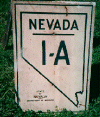 NEVADA 1-A- This is an old state route sign that was posted in
about 1940. It was used on the old route between Fallon (US 50)
and I-80 (US 40) which is now US 95. NEVADA 1-A- This is an old state route sign that was posted in
about 1940. It was used on the old route between Fallon (US 50)
and I-80 (US 40) which is now US 95.
 NO PARKING OR DRIVING ON SIDEWALK- I'm not sure of the conditions
that led up to the posting of this sign but I'll bet it was an
interesting story! This sign is from the 50s. NO PARKING OR DRIVING ON SIDEWALK- I'm not sure of the conditions
that led up to the posting of this sign but I'll bet it was an
interesting story! This sign is from the 50s.
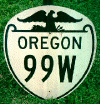 OREGON 99W- Here is a typical 1950s Oregon State route marker. It
shows the eagle symbol at the top of a "trophy shaped"
sign. OREGON 99W- Here is a typical 1950s Oregon State route marker. It
shows the eagle symbol at the top of a "trophy shaped"
sign.
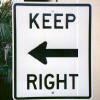 KEEP RIGHT W/ LEFT ARROW- This unusual sign was the result of the
sign maker's not paying attention. In fact, it got all the way to
the point of being mounted before the mistake was discovered!
This one would cause great confusion for sure! KEEP RIGHT W/ LEFT ARROW- This unusual sign was the result of the
sign maker's not paying attention. In fact, it got all the way to
the point of being mounted before the mistake was discovered!
This one would cause great confusion for sure!
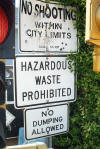
NO SHOOTING- This would be an interesting sign to encounter
while driving down the highway. One might even think twice before heading into
town! The "No Shooting" sign at the top looks fairly intimidating as it's
riddled with bullet holes!

WATCH FOR ICE ON BRIDGE- Kind of a unique sign in that it can
be folded seasonally so that it is not visible in the warmer months. Sign
folds in half and can be secured with the lower mounting bolt.
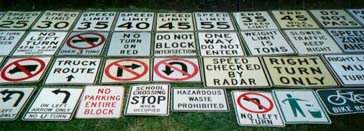
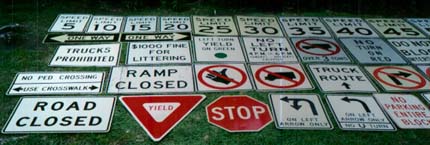
This just a small example of my collection
of over 500 road signs. This particular example shows some of the
regulatory signs I have.
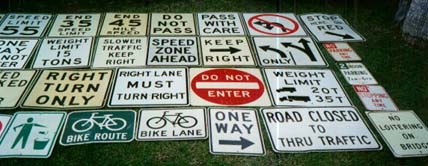

Auto Club & California
Division of Highways "Logo" Signs

OLD AAA SIGN- This sign is one of the oldest signs in my
collection. It is dated from the 1930s and marked the way to San
Diego. These signs are also very rare and expensive. Funny thing
about this sign, I picked this one up just before I did the event
mentioned above in San Diego. Excellent timing!

AAA DIRECTIONAL SIGN- Here is an example of a more recent AAA
sign from the 40s. Note the unusual yellow logo at the bottom.
Most AAA logos on signs from this era were only black-and-white.

Another great
directional sign; this one
from the Automobile Club of
Southern California. This sign
was able to withstand several
bullet wounds, but many of the
old Auto Club signs weren't as
lucky. Usually as soon
as the porcelain is damaged,
it is only a matter of time
before rusting begins and the
porcelain starts to chip and
flake away. Eventually, the
signs would wear away until
they would become unreadable.
 SLOW
LEFT- Another old Auto Club sign from the 1920's. This one was printed in red,
so as to warn motorists
of the upcoming curve. It is an example of one of the first attempts at
distinguishing a warning sign from
others. SLOW
LEFT- Another old Auto Club sign from the 1920's. This one was printed in red,
so as to warn motorists
of the upcoming curve. It is an example of one of the first attempts at
distinguishing a warning sign from
others.
 SLOW/
DANGEROUS CORNER- Many early
Auto Club signs of the 20's
used word descriptions to
explain hazards that are
represented by symbols today.
Unfortunately, these worded
messages could be quite vague.
This particular sign
emphasizes a "dangerous
corner". It lacks the specific
information as to the reason
for the danger or which
corner! SLOW/
DANGEROUS CORNER- Many early
Auto Club signs of the 20's
used word descriptions to
explain hazards that are
represented by symbols today.
Unfortunately, these worded
messages could be quite vague.
This particular sign
emphasizes a "dangerous
corner". It lacks the specific
information as to the reason
for the danger or which
corner!
 NO PARKING ON THIS STREET- An early example of a temporary sign
that the police used to clear traffic for a special event. The
sign is made of a very thin metal (almost tin-like) and had
double holes on the top and bottom to make it easier to mount
with wire to poles or trees. One interesting note: The sign
spells "today" as "to-day". Must have been
the way it was spelled in the early 1920's! NO PARKING ON THIS STREET- An early example of a temporary sign
that the police used to clear traffic for a special event. The
sign is made of a very thin metal (almost tin-like) and had
double holes on the top and bottom to make it easier to mount
with wire to poles or trees. One interesting note: The sign
spells "today" as "to-day". Must have been
the way it was spelled in the early 1920's!
 WINDING ROAD- Don't see many written message signs like this any
more. Unfortunately, these unique messages ("Dangerous
Curves" is another one that comes to mind) gave way to the
"winding arrow" symbol early on. WINDING ROAD- Don't see many written message signs like this any
more. Unfortunately, these unique messages ("Dangerous
Curves" is another one that comes to mind) gave way to the
"winding arrow" symbol early on.

BEGIN
DETOUR 400FT-Another of the
more unusual old signs
illustrating the use of yellow
warning signs before orange
became the standard for
construction zones.

RAILROAD
CROSSING- A great old highway
sign with reflector buttons
and the Auto Club of Southern
California Logo at the bottom.
This is an older version sign
as noted that screws are
holding the back panel that
holds the buttons in place as
opposed to rivets in later
years.
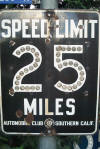
SPEED LIMIT 25 MILES- Great
example representing a typical
Auto Club sign of the 40's
with the glass marbles lining
the "25" and the spelled out
Auto Club logo. Almost every
town in Southern California
had one of these posted along
their residential or Central
Business District. The marbles
are placed inside two
compartments in the back.
These compartments make the
sign a bit thicker in back,
but they are separated enough,
that the sign is mounted
without obstruction.
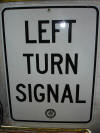
LEFT TURN SIGNAL-
This sign represents the first of a family of signs distinguishing one type of
signal from another. Typically this was mounted beside or below the signal
that used the green left turn arrow indication, in addition to a circular red
and yellow. This sign is in remarkably good shape for it's age (new old stock)
and probably never saw street use. The logo on the bottom is from the California
Division of Highways.
 HOSPITAL-
Another sign from the
Automobile Club of America as
recognized by the yellow
diamond logo.
When I received this sign
originally, it was
blue with white letters (like a typical info sign is today). Then
later (after several rain storms), the blue began to peel off, revealing the original black paint beneath! HOSPITAL-
Another sign from the
Automobile Club of America as
recognized by the yellow
diamond logo.
When I received this sign
originally, it was
blue with white letters (like a typical info sign is today). Then
later (after several rain storms), the blue began to peel off, revealing the original black paint beneath!
 ONYX- This sign was once placed at the entrance of the tiny
community of Onyx. Ca. located in Kern County. The community
today is not in existence anymore. It was named for the type of
mineral that was mined here. This sign was produced by the
California Department of Public Works- the predecessor to
Caltrans. ONYX- This sign was once placed at the entrance of the tiny
community of Onyx. Ca. located in Kern County. The community
today is not in existence anymore. It was named for the type of
mineral that was mined here. This sign was produced by the
California Department of Public Works- the predecessor to
Caltrans.
 LONG
BEACH CITY LIMIT- An old
California Division of
Highways sign that stood at
the city limits. When the
population changed enough to
update, the sign would receive
a small porcelain overlay that
would be screwed on to reflect
the new number. LONG
BEACH CITY LIMIT- An old
California Division of
Highways sign that stood at
the city limits. When the
population changed enough to
update, the sign would receive
a small porcelain overlay that
would be screwed on to reflect
the new number.
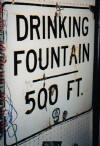 DRINKING
FOUNTAIN 500 FT.- Many early
auto club signs directed weary
travelers to water...both for
the vehicle, and in this case
for the motorist! Drinking
fountains were not a very
common commodity along the
highway...which makes this
sign quite unique! DRINKING
FOUNTAIN 500 FT.- Many early
auto club signs directed weary
travelers to water...both for
the vehicle, and in this case
for the motorist! Drinking
fountains were not a very
common commodity along the
highway...which makes this
sign quite unique!

MUNICIPAL PARKING LOT 1
BLOCK- Another ACSC sign in
excellent condition for it's
age. This sign would normally
be used on a main street to
point the way to the local
downtown lot.
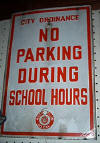
NO PARKING DURING SCHOOL
HOURS- This is one of the
unique specific parking signs
that the ACSC would erect. The
odd thing thing with this
style of sign is that times
weren't given. You had
to know when the school hours
were, and know not to park
during that time! When I
received this sign, it was
still mounted to the top part
of the original post.
The wooden post was painted
white and tapered to a point
on top.
 END 74- This sign was posted in San Juan Capistrano,
California.....right next to the
old mission. It is a pretty old
one from the 1940s, complete with the "California Bear"
at the top and ACSC symbol on the bottom. END 74- This sign was posted in San Juan Capistrano,
California.....right next to the
old mission. It is a pretty old
one from the 1940s, complete with the "California Bear"
at the top and ACSC symbol on the bottom.


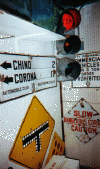
The next few pictures show some of the
Auto Club porcelain signs that I have in my collection. In all, I have 37 signs
of this type. Some of them have glass or plastic "cat eye" reflectors in them.
This photo also shows some of the signals and other items that I collect.
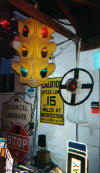
In addition to the signs, this picture shows my
Crouse-Hinds 4-way signal and also a railroad wig-wag.
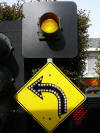
Old curve sign with reflectors and amber beacon.


|